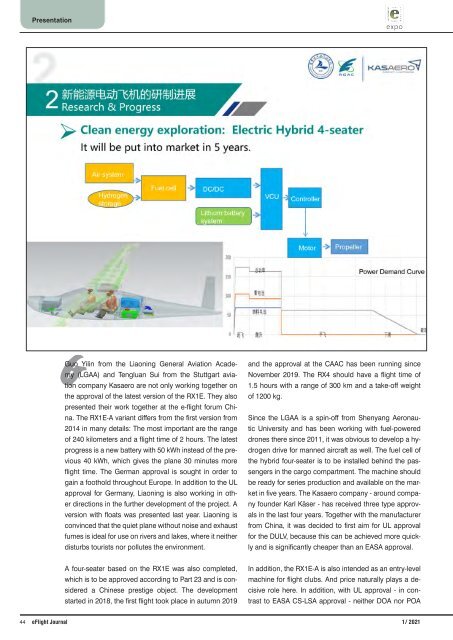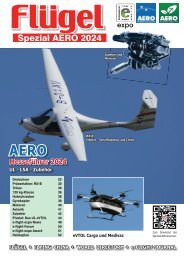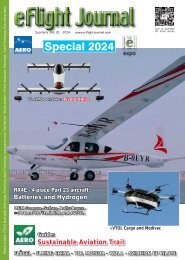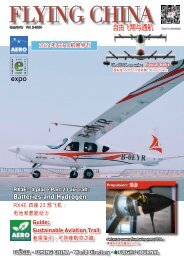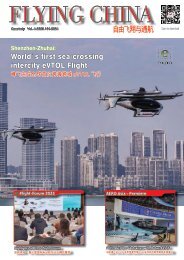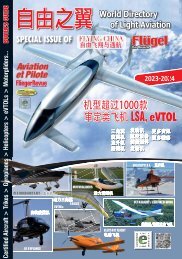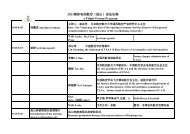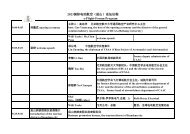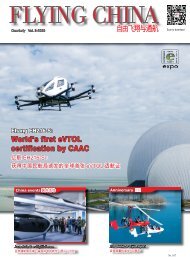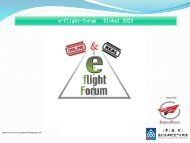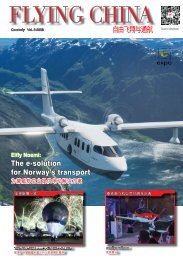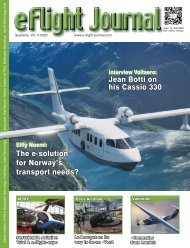eFlightJournal-04-2020+01-2021double issue
E-Flight Journal double issue The Journal for electric aviation, hybrid electrical Aircraft and Evtol from the Publisher Flying Pages
E-Flight Journal double issue
The Journal for electric aviation, hybrid electrical Aircraft and Evtol from the Publisher Flying Pages
You also want an ePaper? Increase the reach of your titles
YUMPU automatically turns print PDFs into web optimized ePapers that Google loves.
Cover eFlight Presentation Story Forum<br />
Guo Yilin from the Liaoning General Aviation Academy<br />
(LGAA) and Tengluan Sui from the Stuttgart aviation<br />
company Kasaero are not only working together on<br />
the approval of the latest version of the RX1E. They also<br />
presented their work together at the e-flight forum China.<br />
The RX1E-A variant differs from the first version from<br />
2014 in many details: The most important are the range<br />
of 240 kilometers and a flight time of 2 hours. The latest<br />
progress is a new battery with 50 kWh instead of the previous<br />
40 kWh, which gives the plane 30 minutes more<br />
flight time. The German approval is sought in order to<br />
gain a foothold throughout Europe. In addition to the UL<br />
approval for Germany, Liaoning is also working in other<br />
directions in the further development of the project. A<br />
version with floats was presented last year. Liaoning is<br />
convinced that the quiet plane without noise and exhaust<br />
fumes is ideal for use on rivers and lakes, where it neither<br />
disturbs tourists nor pollutes the environment.<br />
and the approval at the CAAC has been running since<br />
November 2019. The RX4 should have a flight time of<br />
1.5 hours with a range of 300 km and a take-off weight<br />
of 1200 kg.<br />
Since the LGAA is a spin-off from Shenyang Aeronautic<br />
University and has been working with fuel-powered<br />
drones there since 2011, it was obvious to develop a hydrogen<br />
drive for manned aircraft as well. The fuel cell of<br />
the hybrid four-seater is to be installed behind the passengers<br />
in the cargo compartment. The machine should<br />
be ready for series production and available on the market<br />
in five years. The Kasaero company - around company<br />
founder Karl Käser - has received three type approvals<br />
in the last four years. Together with the manufacturer<br />
from China, it was decided to first aim for UL approval<br />
for the DULV, because this can be achieved more quickly<br />
and is significantly cheaper than an EASA approval.<br />
A four-seater based on the RX1E was also completed,<br />
which is to be approved according to Part 23 and is considered<br />
a Chinese prestige object. The development<br />
started in 2018, the first flight took place in autumn 2019<br />
In addition, the RX1E-A is also intended as an entry-level<br />
machine for flight clubs. And price naturally plays a decisive<br />
role here. In addition, with UL approval - in contrast<br />
to EASA CS-LSA approval - neither DOA nor POA<br />
44 e Flight Journal 1 / 2021


